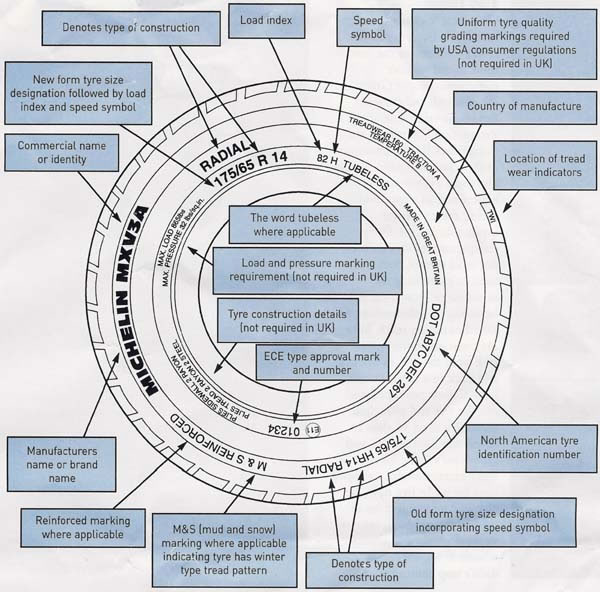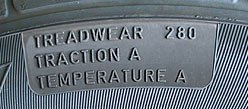
The writing and symbols on the sidewall of your tyre can tell you a
great deal about the tyre itself, such as what weight it can carry and
its maximum speed.
This helpful guide will show you what’s what, so that you can read the
writing on the wall.
The writing on the sidewall of your tyre is like a specification sheet -
it tells you everything you need to know about the tyre.
This information includes details of the tyre’s country of origin, size,
speed rating, type approval, load capability, model number and much,
much more.
Of course, some of this data is stuff only a tyre technician will find
useful, but there are several details you will find handy too.
Let's use the Michelin MXV3A 175/65R14 82H shown as an example
MXV3A
- The Michelin
pattern name.
175
- The nominal section width of the tyre in millimetres.
65
- The aspect ratio of the tyre, (the ratio between the section height
and section width).
R
- Radial
construction. Most car tyres sold in UK are radial except for certain
special tyres such as space saver spares.
14
- The diameter of the rim shown in inches.
82
- The load capacity of the tyre shown as an index. which should be
looked up on the load index table below. In this case the load capacity
of the tyre at the correct inflation pressure is 475kg.
H
- The speed symbol, i.e. the maximum sustainable speed for the tyre at
the load capacity given - in this case 130mph. View the Speed symbol
Table below.
Steel Belted Radial
- as with the
letter "R", this refers to the tyres construction. "Steel Belted" is a
particular form of radial construction.
DOT
- the type approval mark of the American Department of Transport,
showing that our tyres have passed their strict testing procedures.
When a tyre has passed both the American and European test programmes,
you know you can have complete faith in it.
AB7C DEF267
- this is the tyre's production code marking, an internal code that
allows us to determine exactly where and when a tyre was made.
E11 01234
- the ECE type
approval mark and number, showing that the tyre have been tested and
passed as high-quality by the European regulatory authorities.
Made in Great Britain
- the country where the tyre was made.
